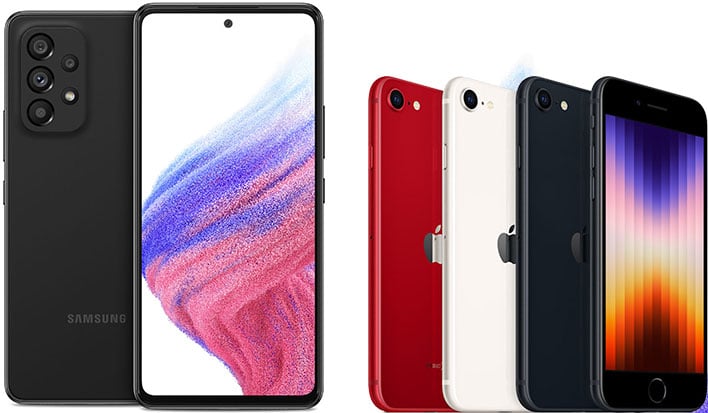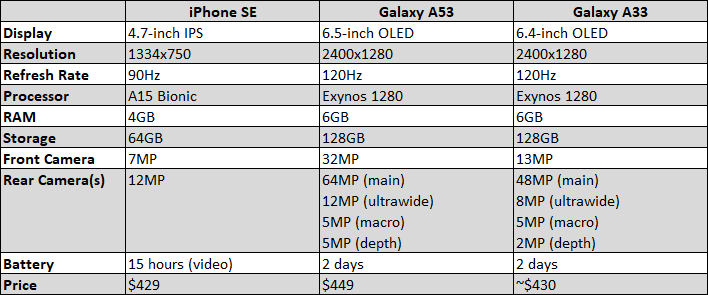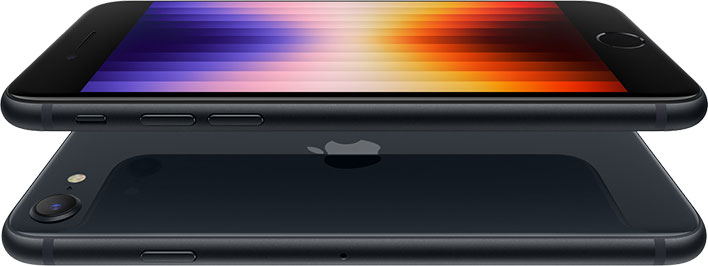Samsung Galaxy A53 Vs iPhone SE 3: Sorry Apple Fans, It's Not Even Close

Apple and Samsung both rolled out mid-range refreshes to their respective smartphone lineups over the past couple weeks, the iPhone SE and Galaxy A53/A33, respectively. Looking strictly at MSRPs (and ignoring any promotions), the cost of entry is similar across the board. This raises the question, is there a better a value proposition to be had? The answer is yes, and it's not even close—Samsung brought its A-game and Apple, well, did what Apple does (it skimped).
Before the iOS faithful bust out their rusty pitchforks and fueled-up flamethrowers, understand this is a comparison of specifications and what each phone offers for the money. And if looking only at the spec sheet, it's clear the Galaxy A53 and even the Galaxy A33 bring substantially more to the mid-range phone market than the latest generation iPhone SE.
Let's have a look...

Note that the above chart compares the baseline configuration. The iPhone SE is also available in 128GB ($479) and 256GB ($579) configurations, while both the Galaxy A53 and A33 can be purchased with 8GB of RAM and 256GB of storage. Additionally, Samsung has only announced UK pricing for the Galaxy A33, so it remains to be seen if it will ship in the US.
Those disclaimers out of the way, the iPhone SE and A33 are virtually tied in pricing at the cost of entry point, while the Galaxy A53 is a tad higher at $449.
Comparing The Display And Cameras

Starting with the display, the iPhone SE wields the smallest of bunch with a 4.7-inch IPS screen, 1334x750 resolution, and 90Hz refresh rate. The Galaxy A53 and A33 are both substantially bigger at 6.5 inches and 6.4 inches, respectively, and both feature an OLED panel with a 120Hz refresh rate.
Whether you'll actually notice a difference between 90Hz and 120Hz on a smartphone is debatable, but there's no question Samsung is using an overall superior panel for its mid-range phones. The added size also translates to a higher resolution on the Galaxy phones.
That's a win for Samsung, though I should point out that there are people who prefer a smaller form factor. The iPhone SE is a compact handset and if that's what you're looking for, the specs advantage of the Galaxy phones may not matter all that much.
The same can't be said about the camera arrangement, though. Samsung beats Apple on both the front and back with 32MP (Galaxy A53) and 13MP (Galaxy A33) selfie cams compared to 7MP on the iPhone SE, and quad-camera arrangements on the rear versus a single 12MP shooter on the iPhone SE. A photo shootout would tell the whole story, but we'd be stunned if both Galaxy phones didn't produce better images in a variety of environments.
Processor, RAM, Storage And Battery

The one place the iPhone SE holds a clear specs advantage is the processor. The A15 Bionic (as also found in the iPhone 13 and iPhone 13 Pro) is a stout processor, and more often than not, it's going to beat the Exynos 1280 SoC inside the Galaxy A53 and A33.
Beyond the processor, though, the Galaxy A53 and A33 pick up the slack with more RAM (6GB to 8GB versus 4GB) and storage (128GB to 256GB versus 64GB). As much as I've liked the iPhone models I've owned (currently clinging to an aging iPhone XS Max), I've always lamented Apple skimping on RAM, especially when I'm juggling multiple open programs—iPhone apps sometimes get to a point where they'll completely refresh themselves when switching back and forth because they've been purged from RAM. That's annoying.
Same goes for the paltry storage. This is 2022 and having just 64GB of onboard storage is disappointing. That would be excusable for a budget handset, and though the iPhone SE is the least expensive iPhone model in Apple's lineup, it commands mid-range dollars. The starting point should really be 128GB.
Samsung got the memo, because the Galaxy A53 an Galaxy A33 both start with 128GB of storage. It's expandable too, by way of a microSD card slot.
Then there's the battery life. We'd need to perform some testing, but Samsung is promising two days of battery life on the Galaxy A53 and Galaxy A33. However, it's not clear in what scenario users might see that kind of longevity. Apple is more transparent in its battery life claims, saying the iPhone SE will last up to 15 hours for video playback (or 10 hours if streaming) and up to 50 hours (two days) of audio playback.
So what's the bottom line? From a pure value (bang-for-buck) standpoint, there's no reason to consider the iPhone SE over the Galaxy A53 or, if you can get your hands on it, the Galaxy A33. Samsung's latest mid-range phones simply offer more for around the same money—an OLED display, faster refresh rate, more RAM, more storage, expandable storage, and a far more robust camera setup.
Of course, in reality it's not necessarily that cut and dry. If you're invested in the iOS ecosystem or otherwise prefer it to Android, then there's value to be for that preference. Same goes for someone in the market for a compact handset—at 6.5 inches and 6.4 inches, the Galaxy A53 and Galaxy A33 pretty big. So despite our potentially inflammatory headline, buy what suits YOU and don't worry about what folks on the internet have to say.

